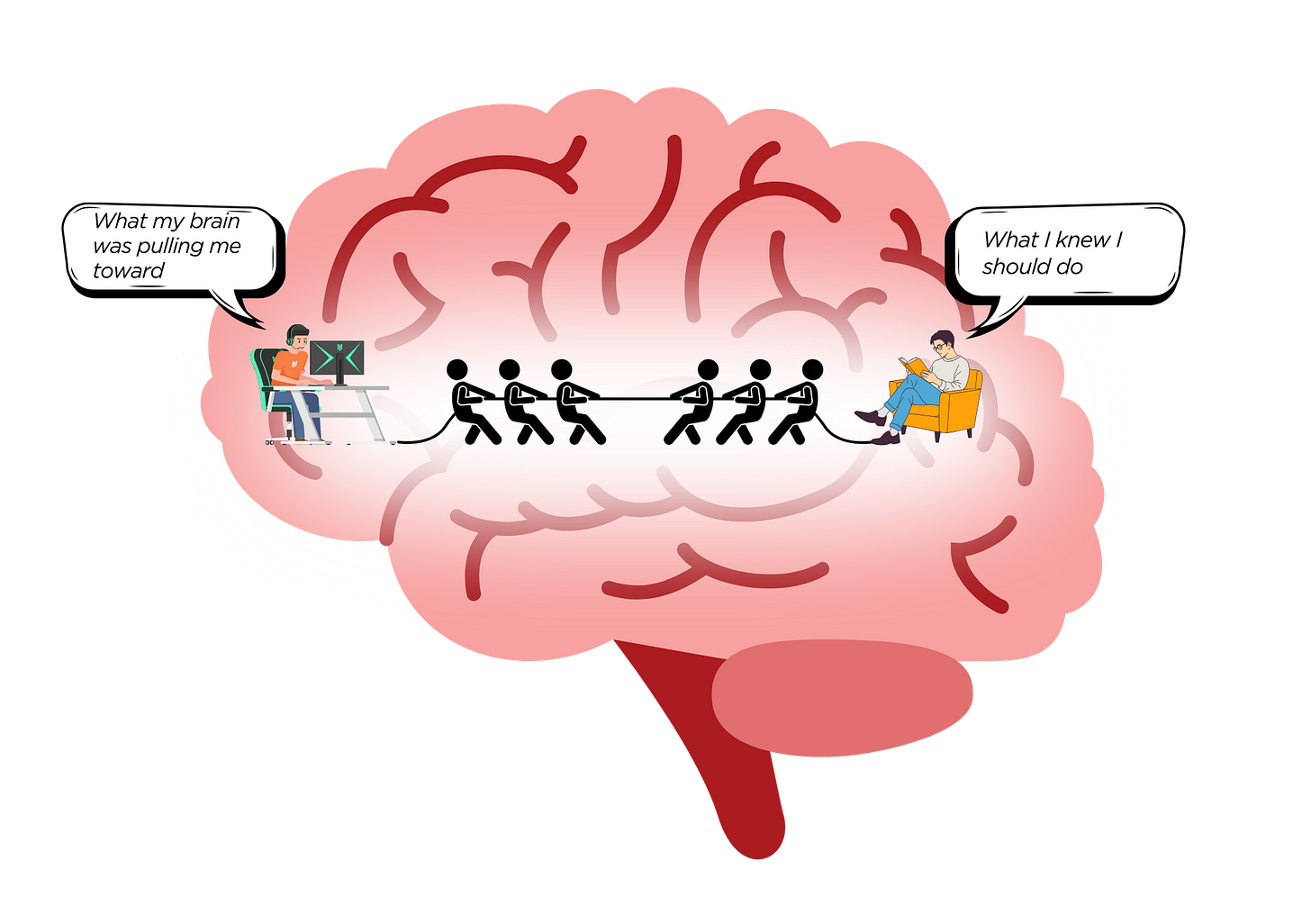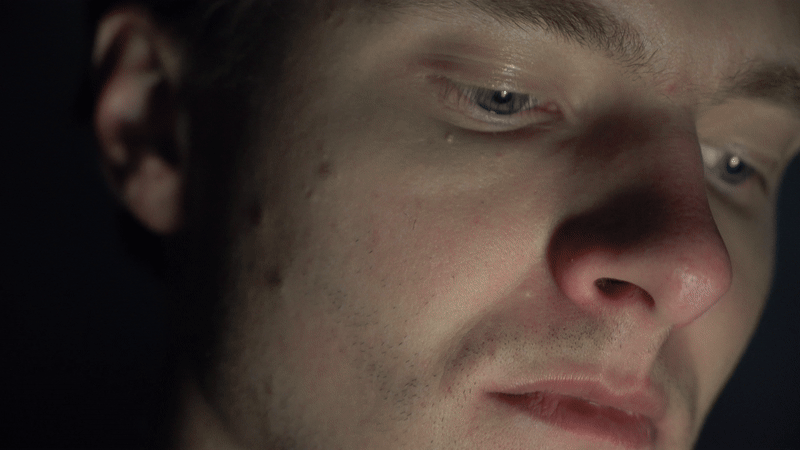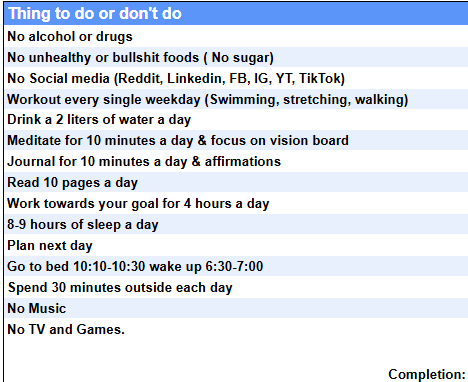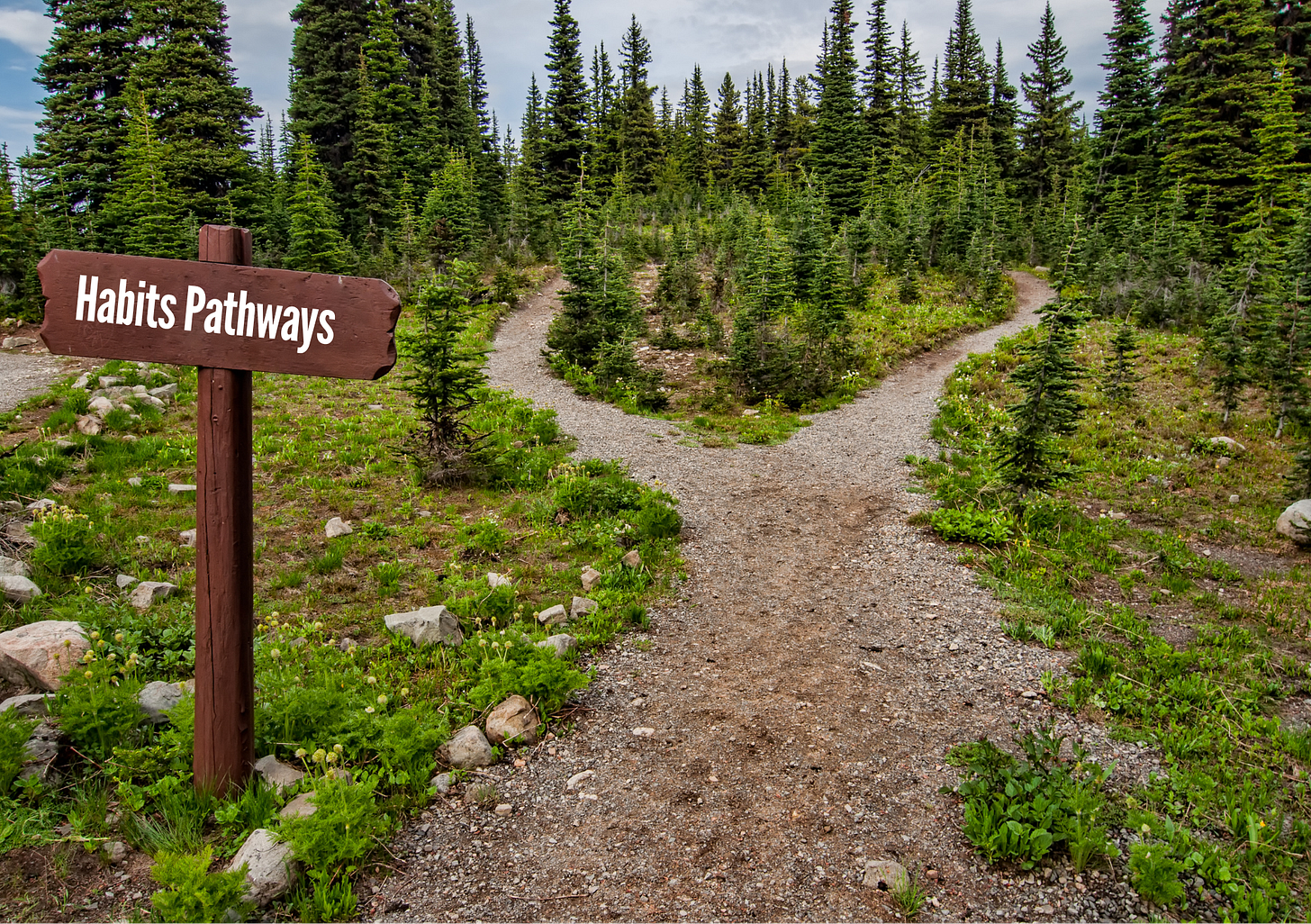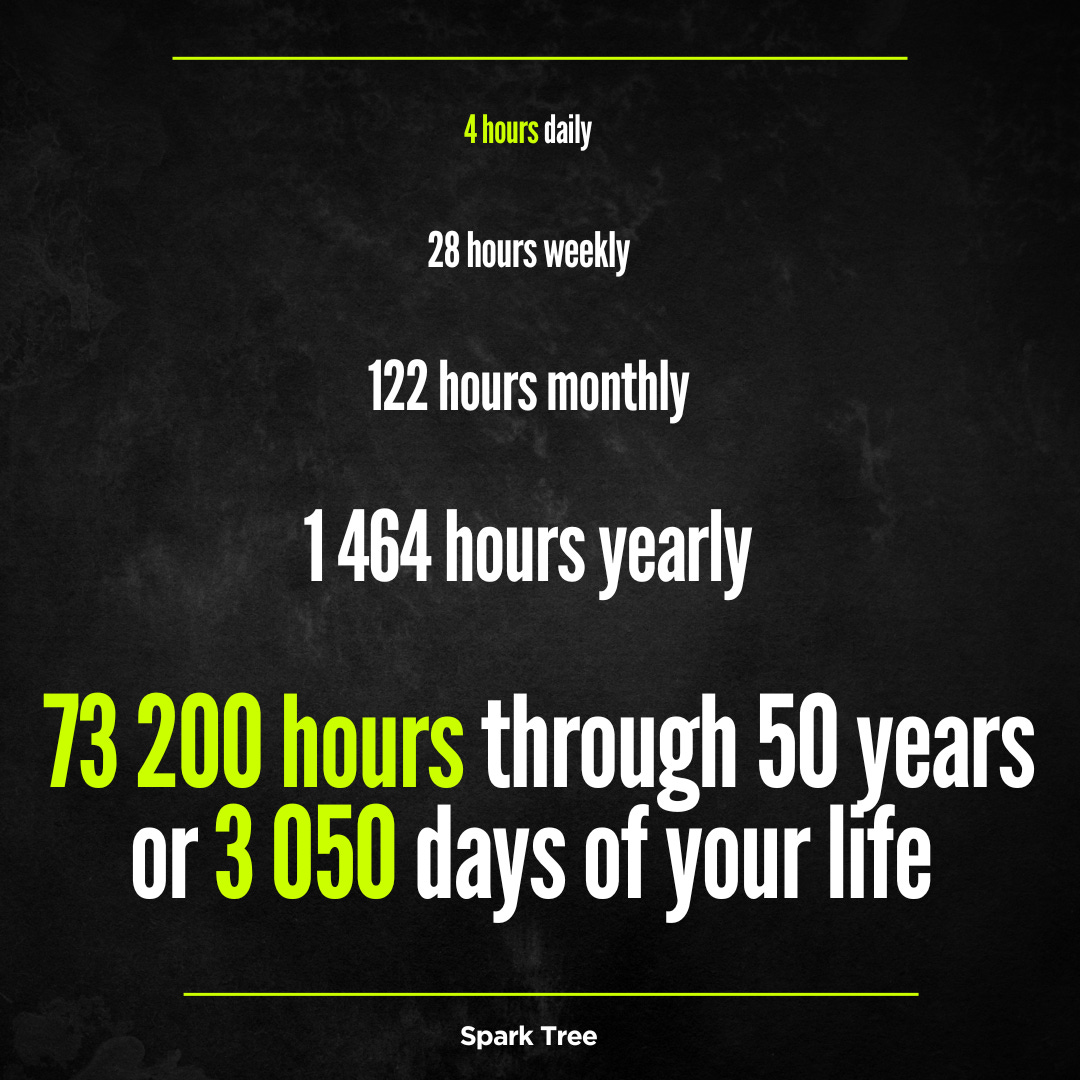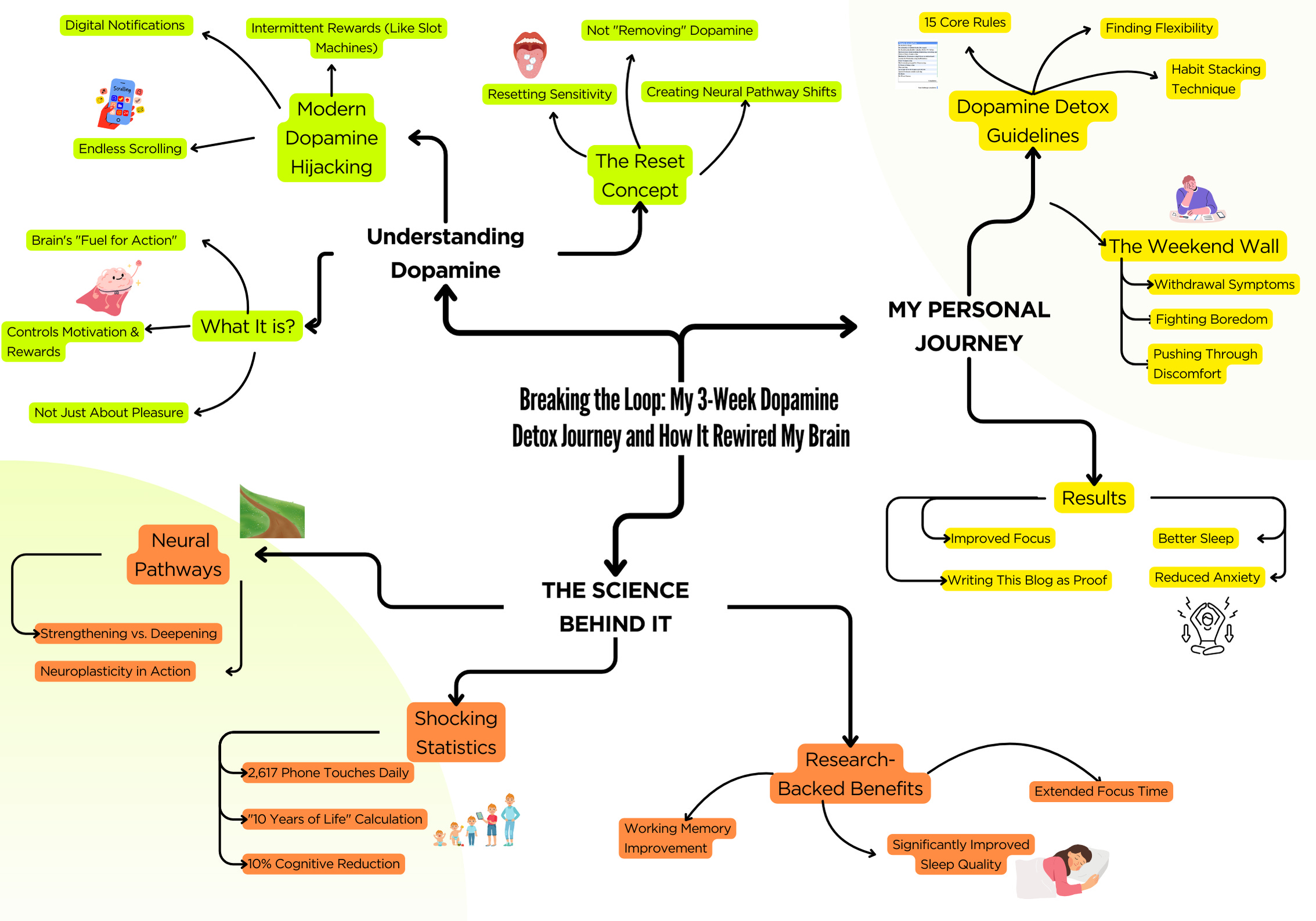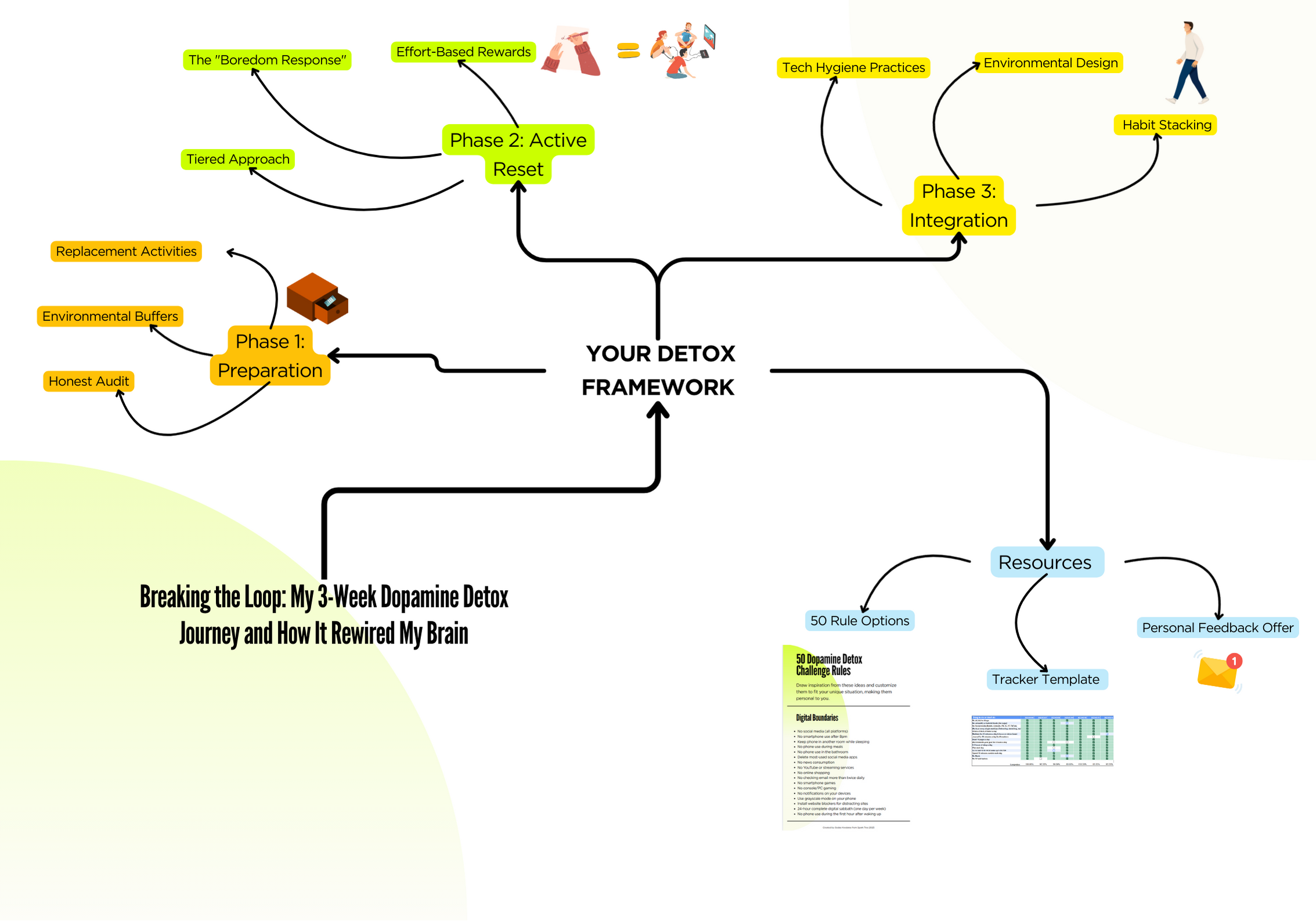Breaking the Loop: My 3-Week Dopamine Detox Journey and How It Rewired My Brain
From Restless Scrolling to Rediscovering Simple Pleasures: A Journey Worth the Struggle
I felt like a mess.
Constantly checking my phone. Gaming for hours. Endlessly scrolling. Fighting the urge to focus on things I actually wanted to do.
Sound familiar?
This wasn't just about poor time management. It was deeper, a constant battle between what I knew I should do and what my brain was pulling me toward. If you're reading this, chances are you've felt that same internal tug-of-war.
How It Started: Accidental Discovery
It began unexpectedly. While watching a dropshipping course in October 2023, the host emphasized the importance of mindset. My first reaction?
"Bullshit. Just give me your marketing strategy and Facebook ad structure. I don’t have time for this mindset stuff."
But I stuck with it, and he suggested a dopamine detox challenge. I thought, "If this gives me an edge over others who skip this part, why not?"
I completed it, launched my shop (which wasn't very successful), and moved on. But something about that experience stuck with me.
Fast forward to March 6, 2025. I had just returned from a holiday trip feeling refreshed and remembered that dopamine challenge. With a desire for a fresh start, I committed again, despite previously spending 4+ hours daily playing mobile games and scrolling through social media, plus countless hours binge-watching Netflix.
What is a Dopamine Detox, Really?
Before sharing what happened, let's clarify what a dopamine detox actually is. Despite what TikTok influencers might claim, you're not actually "detoxing" dopamine from your system, and that's good because complete dopamine depletion would lead to some serious diseases, such as Parkinson's. [1].
The science: Dopamine is a neurotransmitter that plays a crucial role in your brain's reward system. It's not just about pleasure; it governs motivation, learning, and habit formation [2]. Think of dopamine as your brain's "fuel for action." Without it, even basic survival activities like eating would feel pointless.
It's why when dopamine levels are severely depleted (as in certain medical conditions), people can lose all motivation to eat despite being hungry, which for me sounds like a horror movie.
In our daily lives, dopamine is what makes accomplishing goals feel satisfying and what drives us to learn new skills or repeat behaviors that bring rewards.
For me, this feels like a good movie ending.
The problem?
Modern digital technologies are specifically engineered to trigger dopamine releases as frequently as possible [3]:
Each notification
Each scroll reveals new content
Each autoplay feature
They're all designed to keep you hooked by giving you little rewards at unpredictable times - just like slot machines do. The more you use these apps, the less exciting those "rewards" feel over time. It's like needing more sugar in your coffee each day to taste the sweetness [1].
A "dopamine reset" is simply taking a break from these constant digital hits.
It's like giving your brain a chance to reset its taste buds so you can enjoy simpler flavors again [4]. When you step away from these stimulating activities, your brain gradually relearns to appreciate smaller, more natural rewards.
So when I decided to try this reset for myself, I knew I needed clear rules to follow - not just vague intentions to 'use my phone less.' Having specific rules helps reduce the mental energy needed to make decisions and gives you clarity when temptation strikes.
Setting Up My Challenge
I created a simple Google sheet with 15 rules to follow throughout the week:
This list might seem intimidating, but I built some flexibility. For exercise, I gave myself options: it could be stretching, swimming, or a simple walk, but I committed to 30-60 minutes daily. The key was consistency and getting it through, not perfection.
I also discovered the power of habit stacking. Instead of driving to work, I'd walk, which satisfied both my exercise requirement and my "30 minutes outside" rule simultaneously. Finding these small efficiencies made the challenge more manageable and still rewarding.
Finding the Sweet Spot
What I learned about creating a dopamine detox challenge is that balance is crucial. Make it too easy, and you won't see results. Make it too restrictive with 30+ inflexible set-in-stone rules, and you'll likely fail or drive yourself crazy.
My suggestion? Don't be too hard on yourself. The goal isn't perfection; it's progress. There's something incredibly satisfying about checking off those boxes in your tracker and watching your completion percentage rise. That feeling of accomplishment delivers a much healthier dopamine hit that reinforces your new habits.
Want to Try This Yourself?
If you're thinking about giving this a shot, I've put together some resources that might help:
I've created a list of 50 potential rules you can choose from to build your own challenge. I'll also share my simple Google Sheets template that helped me stay on track.
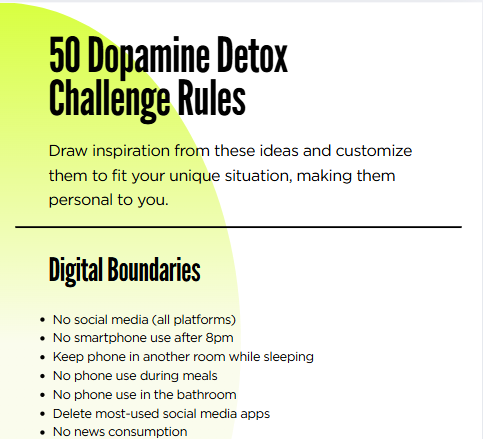

Not sure if your plan will work? Feel free to send it my way on Instagram or on Substack after you've created it. I'd happily give you some feedback based on what I've learned.
All you need to do is subscribe to join our community. Together, we can break free from those dopamine loops and build better habits.
Since I started mid-week on Wednesday, the beginning was exciting. I felt like I was doing something useful for myself and looked forward to the week ahead.
The Weekend Wall: When Reality Hit
Everything changed when the weekend arrived. The empty free time hit me like a wave when compared to the weekdays when there is work that you need to do that fills your day.
I found myself staring at walls, feeling an almost physical discomfort sometimes from the boredom. My mind constantly wanders towards reaching for my phone. There were moments when I felt restless and irritable and struggled to concentrate. Funny enough, these were the things precisely the opposite of what I'd hoped to achieve during this challenge.
Luckily, I found the explanation: science calls these "behavioral withdrawal symptoms" [10].
The initial difficulty isn't a sign of failure; it's evidence that the detox is working.
The sad thing is I didn’t know it before doing it; I just pushed it through. But now you know, and if it hits you, you will see why this is happening.
Your brain is essentially protesting the removal of easy dopamine hits, just like a child becoming a demon when candy is taken away.
But pushing through this discomfort led to my biggest breakthrough.
The Revelation: Breaking Free from the "Task" Mindset
With all that uncomfortable free time came a powerful realization: I had been living with a distorted relationship to enjoyment. For years, I saw every beneficial and enjoyable activity- reading, exercising, walking, cooking - as a task I needed to rush through before I could "really relax" with games, TV shows, or social media.
The irony? Those supposedly relaxing activities usually left me feeling terrible at the end of each day. Because I never had a sense of when to stop.
As I continued the detox, I began rediscovering pleasure in activities that required effort but at the same time gave me a deeper satisfaction: reading science fiction, baking cookies, or taking unhurried walks. These weren't chores to endure but experiences worth living.
The Rewards: What Made It All Worthwhile
By the end of the dopamine detox challenge, the benefits became undeniable:
My sleep was slightly transformed, and I fell asleep faster and woke naturally refreshed. My anxiety levels dropped as my mind grew calmer and less noisy. I could focus on reading for extended periods without feeling the itch to check notifications.
Even my relationship with time changed. Days felt luxuriously long rather than disappearing in a blur of scrolling, especially on the weekends and after work.
These personal observations align with research showing that a structured digital detox leads to these improvements:
Working memory shows significant improvement, with studies demonstrating enhanced cognitive performance after digital detoxes [8]
Sleep quality significantly improves, with studies showing enhanced sleep duration and efficiency after reducing screen time. [6]
Focus and attention span show measurable improvement, with participants demonstrating enhanced sustained attention after digital detox periods. [7]
If you ask me? All these improvements, just after a week, where should I sign up?
But perhaps the most liberating discovery? I hadn't missed anything important. The world continued spinning, and I was fully present for the parts that actually mattered.
The Decision: Continue or Quit?
At the challenge's end, I faced a dilemma. My subconscious was telling me I'd already done a great job and could return to my old habits. But something deeper urged me to continue and see where this path would lead.
I decided to continue for another 2.5 weeks, until I stumbled and played video games for almost 10 straight hours. Ouch, I think it’s not the end you would expect.
But here's the wonderful part: Since I had been practicing mindfulness and developed stronger emotional awareness, I managed to avoid falling back into the same destructive loop. I got back on track, now viewing the dopamine detox not as a one-time challenge but as the foundation for a new relationship with technology and attention. Writing this 3400-word blog post is solid proof to me that this dopamine stuff actually works.
The Science of Sustainable Habits
The most profound insight from my extended detox wasn't simply about reducing technology and sugar use; it was about creating space in my mind. With my brain's reward system recalibrated, I could actually choose how to direct my attention.
Neuroplasticity research explains why: what we repeatedly do literally shapes our neural architecture [18].
Each time we resist the urge to check our phones and choose focused work instead, we strengthen those neural pathways. It's like walking through a meadow along the same route every day; at first, the grass springs back, but eventually, a clear path forms that becomes easier to follow. Each time we surrender to distraction, we deepen those other, less helpful paths instead.
This knowledge transformed how I approach my daily habits:
Easy Going Mornings - Instead of grabbing a phone the first thing in the morning, I prefer a 30-minute reading session.
Notification minimalism - Only essential communications trigger alerts, turning off almost every notification.
Stimulation cycling - implementing this at the moment, giving myself a time bank for completing some tasks, where I can spend it on gaming, social media, or a TV series.
Daily reflection - one time per day, usually in the second part of the day, I wrote a diary of how my day went.
Emotional clearance - hard and unexpected things don’t bother me that much anymore due to doing daily guided meditation sessions.
The stakes became clearer when I learned that the average person touches (tap, swipe, click) their phone 2,617 times daily [13], and just having your smartphone visible reduces cognitive capacity by 10%, even when powered off [14].
It is very easy to test how attention-seeking your device is by just placing your phone out of your sight and then putting it near you while you are working, reading, or doing something that requires paying attention.
I really love this kind of tricks that require almost zero to no effort to implement but have significant results for you.
My own revelation? My previous 4-hour daily social media habit would consume roughly 10 years of my waking life if it continued. Ten years! Would I look back at 80 and wish I'd spent a decade scrolling? The answer is obvious.
A Framework For Your Own Reset
If you're inspired to try your own dopamine reset, here's a simplified framework based on both scientific literature and my personal experience:
Phase 1: Preparation (Days 1-2)
Conduct an honest audit: Track your current usage patterns. Identify your top dopamine triggers, not just obvious ones like social media but also online shopping, news checking, sugar, or video streaming.
Create environmental buffers: Delete social apps from your phone or limit your time usage per day to 0 and put a complex password for them, which would be hard to memorize; use website blockers, I prefer newsfeed eridicator; put gaming consoles in storage don’t see don’t trigger, and create physical distance from triggers, like putting a phone inside other room.
Plan replacement activities: Have ready alternatives that engage different neural pathways: physical exercise, reading, cooking, in-person socializing, meditation, or learning a new skill.
Phase 2: Active Reset (Days 3-14)
Implement a tiered approach: Rather than eliminating all pleasurable activities (an extreme that can backfire), focus on reducing digital overstimulation first.
Practice the "boredom response": When withdrawal cravings hit, resist the urge to seek immediate stimulation. Scientists found out that boredom usually leads to creativity. I found that simply going through the craving and waiting 5-10 minutes led to doing things that would benefit me, such as reading, going for a walk, or sometimes taking a quick nap and relaxing.
Engage in "effort-based rewards": Activities requiring effort but yielding satisfaction help recalibrate your reward system toward delayed gratification, and challenging tasks become normal and don’t scare you anymore.
Phase 3: Sustainable Integration (Days 15+)
Establish "tech hygiene" practices: Create rules for ongoing digital wellness, such as:
No phones in the bedroom. I love to put my phone in another room before going to bed; this also helps me wake up when I have to turn off the alarm.
Social media or, for me, gaming use is moderated from 0 - 10 hours/week. So I am not pushing myself to use it if I don’t feel like it I am not using.
Evening rituals, that you can do before going to bed since don’t use your phone 1 hour bed most likely won’t suit you if you don’t know what you can do instead that hour, I prefer, reading a book, journaling my day, taking hot shower, or discussing with my girlfriend how the day went.
Implement habit stacking: Attach new productive habits to existing routines. For example: "After morning coffee, I'll write 500 words in my journal."
Design environmental supports: Modify your spaces to reinforce desired behaviors, creating dedicated areas for deep work, keeping charging stations away from workspaces.
Final Thoughts: It's Not About Perfection
Remember my 10-hour gaming relapse? That could have been the end of my journey. In the past, one slip would have sent me spiraling back into old patterns, accompanied by harsh self-criticism.
But the dopamine reset had given me something more valuable than perfect adherence to rules; it had taught me self-awareness and resilience. I now understand that transformation isn't about perfection; it's about consistently returning to what serves you best, especially after the pitfalls, which inevitably happen in life.
We live in an unprecedented moment in human history, surrounded by technologies specifically engineered to capture and monetize our attention. The average smartphone user faces more persuasion attempts in a day than our ancestors encountered in a lifetime. Our brains simply didn't evolve for this environment.
A dopamine reset isn't about technological abstinence; it's about reclaiming neurological sovereignty. It's about ensuring that you're the architect of your attention rather than surrendering it to algorithms designed to maximize engagement at any cost.
Have you tried a dopamine detox yourself? I'd love to hear about your journey in the comments below - the challenges you faced, the benefits you noticed, or questions you still have.
Ready to Start Your Own Reset?
To help you succeed where many struggle, I've prepared a few practical resources:
A curated list of 50 potential dopamine detox rules you can mix and match based on your lifestyle
My personal Google Sheets tracker template (the exact one that kept me accountable)
Free personalized feedback on your plan - just send it to me on Instagram or Substack
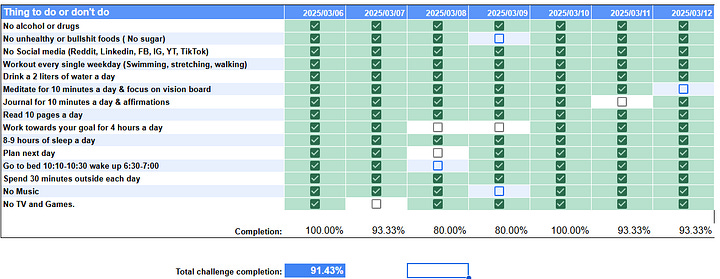
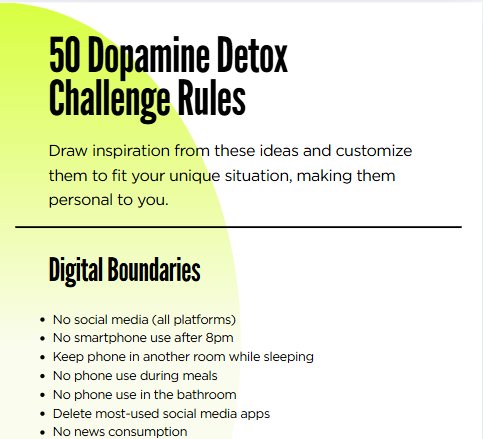
Simply subscribe to access these resources and join our community of people rebuilding healthier relationships with technology and attention.
If this resonated with you, please consider sharing with someone who might be struggling with digital distractions or feeling trapped in unhealthy dopamine loops. Sometimes, all it takes is seeing that others have broken free to find the courage to try.
P.S. I've included a visual mind map below that summarizes the key concepts from this post. Save it as a quick reference for your own dopamine detox journey!
References:
[1] Lembke, A. (2023). Dopamine Nation: Finding Balance in the Age of Indulgence. Dutton.
[2] Volkow, N.D., et al. (2024). "Dopamine, Learning, and Motivation." Journal of Neuroscience, 44(2), 278-289.
[3] Harris, T. (2023). "The Attention Economy: How Tech Companies Monetize Distraction." Stanford Social Innovation Review.
[4] Sepah, C. (2024). "The Dopamine Fasting Method." Clinical Psychology Review, 89, 102055.
[6] Moore Momentum. (2024). Dopamine Detox: Science Over Hype.
[7] PMC. (2024). "The role of dopamine in cognitive effort" National Library of Medicine.
[8] Opal. (2024). What is Dopamine Detox.
[9] Berridge, K.C., & Robinson, T.E. (2023). "Liking, wanting, and the incentive-sensitization theory of addiction." American Psychologist, 78(4), 337-350.
[10] Choosing Therapy. (2025). Dopamine Detox: A Comprehensive Guide.
[11] Lally, P., et al. (2023). "How are habits formed: Modelling habit formation in the real world." European Journal of Social Psychology, 53(1), 130-136.
[12] Business Insider. (2014). Studies Find Boredom Leads To Creativity.
[13] Dscout. (2024). Mobile Touches: A Study on Humans and Their Tech.
[14] Ward, A.F., et al. (2023). "Brain Drain: The Mere Presence of One's Own Smartphone Reduces Available Cognitive Capacity." Journal of the Association for Consumer Research, 8(2), 140-154.
[15] Eyal, N. (2022). Hooked: How to Build Habit-Forming Products. Portfolio.
[16] Twenge, J.M., et al. (2023). "Increases in Depressive Symptoms, Suicide-Related Outcomes, and Suicide Rates Among U.S. Adolescents After 2010 and Links to Increased New Media Screen Time." Clinical Psychological Science, 11(1), 57-76.
[17] DataReportal. (2025). Digital 2025: Global Digital Overview.
[18] Doidge, N. (2024). The Brain That Changes Itself: Stories of Personal Triumph from the Frontiers of Brain Science. Penguin Books.


